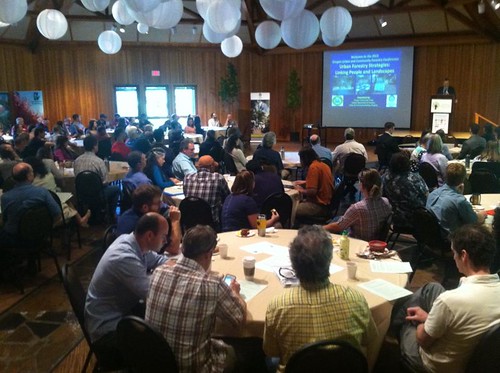The Link Between Trees & Human Health is About Life & Death
This year’s Urban & Community Forestry Conference, sponsored by Oregon Community Trees and Oregon Department of Forestry, focused on “Urban Forestry Strategies: Linking People & Landscapes.” Each speaker’s presentation shed light on the connections between trees and human health.

Keynote speaker Dr. Kathy Wolf, Research Social Scientist and Program Director at the USDA Forest Service, University of Washington, noted that a great number of studies have been conducted on the ecosystem benefits that trees provide. These studies show that, by cleaning our air and water, reducing energy use, cooling streams for native fish, reducing erosion and more, trees are far better than people at multi-tasking. They are “the hard workers in the background of our lives.”
An increasing number of recent studies are demonstrating trees’ relationship to human health and well-being. With more funding, the research will soon reveal the causal relationships between the two.
Topics Dr. Wolf touched on included the cognitive and health advantages of saving children from “nature-deficit disorder” and a growing understanding of “attention restoration theory.” In workplaces, for example, just a 15 or 30-minute break spent in nature during a work day increases job satisfaction, reduces employee illness, and enhances people’s ability to focus on their work when they return to the office.

Dr. Roger Ulrich has conducted numerous studies on the healing nature of plants. Friends of Trees looks forward to partnering with Legacy Health to sponsor Dr. Ulrich’s next visit to Portland on Sept. 12.
Dr. Wolf directed anyone looking for information about trees and human health to visit www.greenhealth.washington.edu, where 40-years of studies about the benefits of trees have been summarized, organized, and highlighted with key facts. To learn more about the human dimensions of urban forestry and urban greening, visit www.naturewithin.info.
Points made by others who spoke at the conference include the following:
• Dr. Thomas Maness, Dean, OSU College of Forestry: About 85% of our fresh water comes from our forests. Wouldn’t it be great if, similar to the 100-mile diet, everything we ate and used in the Portland metro area came from the 500-mile forest that surrounds us?
• Dr. Jenna Tilt, OSU, Geography: People prefer to enjoy nature within a 10-minute or 10-mile radius of their home. Urban communities need close proximity to green spaces, access points to the green spaces, and time to spend in them.


• Dr. Vivek Shandas, PSU, Toulan School of Urban Studies & Planning: Dr. Shandas measured the causal relationship between vegetation and NO2 levels. Using a map made by PSU’s David Sailor, which shows the warmest areas near roadways, parking lots and warehouses, where there are relatively few trees, he could see the locations with the greatest urban heat island effect were downtown, the inner east side of Portland, the Northwest industrial district, the airport and surrounding Columbia Corridor, and along freeways and busy arterials such as 82nd Avenue, Sandy Boulevard, Foster Road, and Killingsworth Street. He drove around the East side, measured the heat of the pavement, and placed passive NO2 receptors in locations with varying densities of vegetation. This Portland Tribune article describes more about the study.
Dr. Shandas is conducting the research in other cities to assess the relationship between tree cover and air quality, acute respiratory illness, and healthcare costs.
Portland researcher, Dr. Geoffrey Donovan of the USFS PNW Research Station, wrapped up the scientific presentations by describing two of the studies he has conducted. The first one correlated the presence of trees with higher baby birth weights. Studies have shown a causal relationship between placing people in a natural environment and reduced blood pressure, heart rate and other measures of stress. Dr. Donovan concluded that pregnant women in areas with more trees have lower stress rates and, therefore, babies with higher birth weights. “Your birth weight and health sets you on a health trajectory for life,” said Dr. Donovan.

Dr. Donovan also studied 1,296 counties in 15 states that lost vast numbers of trees from a devastating emerald ash borer infestation. Because studies have shown a causal relationship between trees and improved air quality in addition to a relationship between trees and lowered blood pressure and heart rates, Dr. Donovan studied the rates of death from cardiovascular disease and respiratory disease. Even accounting for variables like income, race and education, the evidence was clear. Death rates from both diseases increased in the counties that lost the most trees. The study was published in a recent issue of the American Journal of Preventive Medicine, and Dr. Donovan was interviewed on PBS last week about the study.
“It’s difficult to think of something more profound,” Dr. Donovan concluded about the relationship between trees and human health. “This is about life and death.”
–TR
